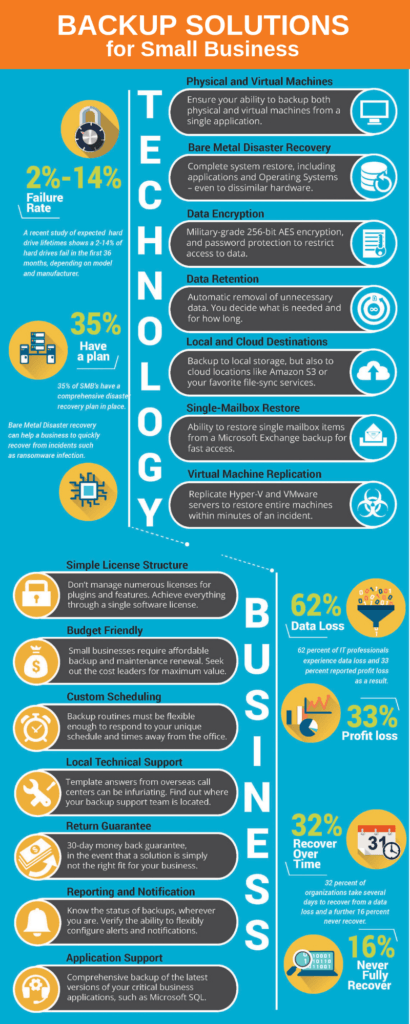
A Set of Recommendations for Establishing a Secure Policy Around BYOD
As a provider of IT and security solutions, we are always surprised when an older topic like BYOD...
Data is the lifeblood of any small or medium-sized business (SMB). Especially as we continue to rely more and more on digital systems, data availability is critical to serving your customers and winning new business.
That’s why it’s so important for SMBs to treat backup solutions like insurance. You wouldn’t buy a house without home insurance, you don’t want to go to the hospital without health insurance, and you don’t want to get into an accident without auto insurance.
But we still see so many SMBs thinking they can get by with a simple off the shelf backup solution. That all changes once they’re in crisis mode.
The first time you experience any amount of downtime without backup, you’ll know exactly why this insurance is so necessary:
The numbers speak for themselves.
There’s a distinction we have to make, though. You might look at these stats and think you’re safe from data disasters. Or even worse, you might assume that your data is automatically backed up because it’s a part of a cloud service like Salesforce or Outlook. Truth be told, the only data being backed up is a version of that data with limited abilities to get it back.
Here’s the point: when your server dies, and your mission-critical systems are failing, you will have to look for a costly replacement. Why is it costlier than migrating server data before it fails? Because when a server goes down unexpectantly, the software and data have to be re-built, re-installed, and configured with proper settings and preferences. It could take days. Can you afford that kind of downtime?
It’s time for SMBs to take backup more seriously. Here’s what you need to know.
We’ve met SMB leaders who have lost mission-critical data sets, irreplaceable documents, and even entire sets of financial records. And still, some of them don’t take the time (or spend the money) to back up their data and systems.
For many businesses that don’t have backup solutions in place, the reason is more about effort than cost.
In the past, tape drives have been the primary means of backup. You could conduct full, daily backups of your entire storage environment and ship them to a storage facility for safekeeping.
But that technology is four decades old. It’s reliable, but the technology isn’t necessarily compatible with the modern, incremental approach to backups and the data retrieval process is cumbersome, to say the least.
Rather than dealing with these legacy solutions, many SMB leaders took the risk of an “it’ll never happen to me” mindset. Now, thanks to new software, hardware, and services for backup, it’s easier than ever to give your data and systems the protection they need.

If you’ve been getting along without a backup strategy for years, there’s one question you might want to be answered—why change?
In a recent survey, Unitrends identified many of the key business drivers for backing up your data. Here are the three that stand out most:
Simply deciding to invest in stronger backup solutions is just the first step, though. Not all solutions are created equal, so it’s important to understand your specific needs and the options available to you.
That means knowing about all four different types of backup before diving headfirst into a particular investment.
As you evaluate potential backup solutions, there are four main categories to keep in mind—cloud, hybrid cloud, image-based, and software-based backup.
Each type of backup has its strengths and weaknesses, and the key to success is finding the one that best-fits your environment.
When evaluating these different options, it’s important to recognize the difference between strict backup and the broader concept of business continuity.
Backup plays a critical role in data availability, but business continuity is a higher-level concern that focuses on how quickly you can get your business operating again in the case of system failure. Unfortunately, 75% of SMBs operate without any disaster recovery plan, and only 25% are “extremely confident” in their ability to restore data when compromised.
Evaluating the different types of backup solutions and the role they’ll play in business continuity comes down to two key terms—recovery time objective (RTO) and recovery point objective (RPO).
Your recovery time objective is the duration of time within which a business must be restored after a disruption to avoid unacceptable consequences. Recovery point objective, on the other hand, is the maximum tolerable period in which data might be lost due to a disaster. With RTO, you determine the maximum amount of time you can be without data before the business is at risk, whereas RPO tells you how often to perform backups.
Once you’ve calculated your unique RPO and RTO, you’ll have a better understanding of how each type of backup solution will fit into your overall strategy. Then, it’s all about evaluating the strengths and weaknesses of each.
While there are plenty of potential backup solutions and services to consider, there are three main characteristics that you should value most:
Backup and business continuity shouldn’t overwhelm your business. On the contrary, they’re meant as insurance policies against any outages, disruptions, or disasters. But getting the most out of a backup solution doesn’t mean sinking so much of your time and effort into new processes.
If you want to learn more about monitored backup services, contact us today and learn how we can help you implement this data insurance policy.

As a provider of IT and security solutions, we are always surprised when an older topic like BYOD...

Many business practices change over time, but few have the potential to radically alter how we live and work. Cloud computing is one innovation that’s not only here to...